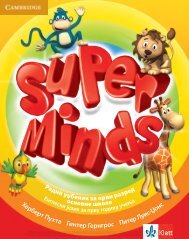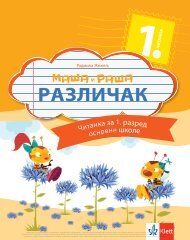Енглески језик 8, уџбеник, старо издање, Нови Логос
- No tags were found...
Create successful ePaper yourself
Turn your PDF publications into a flip-book with our unique Google optimized e-Paper software.
English Plus Options<br />
CURRICULUM EXTRA Biology: The brain<br />
I can understand a text about the brain and its functions.<br />
7<br />
cerebrum<br />
hypothalamus<br />
1 Match definitions 1–5 with the<br />
words in blue in the text.<br />
1 Always the same.<br />
2 Extremely old and not highly<br />
developed.<br />
3 Not consciously controlled.<br />
4 Halves.<br />
5 Developed and changed<br />
gradually over time.<br />
amygdala<br />
brain stem<br />
cerebellum<br />
2 3.17 Read and listen to the<br />
text. What are the three main<br />
parts of the brain called?<br />
spinal cord<br />
Understanding your brain<br />
Every animal has a brain, but the human brain is unique. It<br />
controls everything we do, think or feel and allows us to speak<br />
and imagine. It constantly analyses and responds to messages<br />
from outside and inside the body.<br />
The three main parts of the brain – the brain stem, the cerebellum<br />
and the cerebrum – have evolved over millions of years. The brain<br />
stem is the most primitive part that we share with all animals.<br />
It links the rest of the brain to the spinal cord and controls<br />
involuntary body functions like breathing and digestion, as well<br />
as basic instincts like danger. It may be responsible for phobias,<br />
which scientists think are primitive survival instincts.<br />
Next to evolve was the cerebellum at the back of the brain. It<br />
isn’t very large, but it contains over half of all the brain cells, or<br />
neurones, and deals with huge amounts of information. It controls<br />
balance, movement and coordination and without it we couldn’t<br />
stand or walk straight.<br />
The largest and final part of the brain to develop was the<br />
cerebrum. This is the centre of thinking, memory and language,<br />
and it is highly specialized in humans. It is this part that makes<br />
us more intelligent than other animals. The cerebrum is divided<br />
into two hemispheres which each control opposite sides of the<br />
body and seem to have slightly different functions. The right<br />
hemisphere helps us think about creative things like music, art and<br />
shapes, while the left side is better at maths, logic and language.<br />
Other smaller parts of the brain also have important functions.<br />
The hypothalamus is essential for keeping our body temperature<br />
constant, while the amygdala below it controls our emotions.<br />
The human brain is incredibly complex and scientists are only<br />
just starting to understand it. A lot more research is needed to<br />
complete the picture.<br />
3 Read the text again and answer<br />
the questions.<br />
1 Which part of the body does the<br />
brain stem connect to the rest of<br />
the brain?<br />
2 What body functions does the<br />
brain stem control?<br />
3 Where are the majority of the<br />
brain’s neurones?<br />
4 Which part of the brain was the<br />
last to develop?<br />
5 Why does the cerebrum make<br />
humans unique?<br />
6 What would happen if the<br />
hypothalamus was damaged?<br />
4 ACTIVATE Work with a partner and<br />
decide which parts of the brain are<br />
responsible for 1–6.<br />
1 A fear of snakes.<br />
2 Being good at drawing.<br />
3 Being good at solving problems.<br />
4 Being able to ride a bike.<br />
5 Feeling unhappy.<br />
6 Keeping cool in hot weather.<br />
102 Curriculum extra<br />
Property of Oxford University Press. Provided for and restricted to creating accessible formats for users with a disability.

















